Wednesday, May 31, 2006
A Significant Day
While there's all manner of interesting information derived from the July issue of Wizard (#177) to report upon, (most of it pertaining to the upcoming Wonder Woman relaunch), it will all have to wait until later in the week.
Because today is one of those singular days.
For on May 31, 1986, my wife and I were married in New York City.
From J. Stevenson and P. Davidson, (eds.), Early Modern Women Poets: An Anthology, (Oxford UP, 2001), pp. 255-6.
Because today is one of those singular days.
For on May 31, 1986, my wife and I were married in New York City.
How swiftly time doth pass away
Where happiness completes the day.
Weeks, months, and years but moment prove
To those that nobly are in love.
This computations only known
To them that our pure flame can own.
Succeeding years example take
By those are past; their numbers wake
Envy, whilst with a will resigned
No will is known til th'others mind.
— Gertrude Thimelby, née Aston (c. 1615-c.1670), To Her Husband, on New Year's Day 1651
From J. Stevenson and P. Davidson, (eds.), Early Modern Women Poets: An Anthology, (Oxford UP, 2001), pp. 255-6.
Saturday, May 27, 2006
A Matter of Professional Courtesy

At the "5.2 about 52" segment at Newsarama, a reader posed the following question about the "History of the DCU" section of the comic.
What is the goal of the History of the DC Universe backups currently? If it is to clear things up for most people, it seems that using the most muddied and not-so-recognizable character of Donna Troy isn't a great choice. Putting out history in the first two issues that some of which might be confirmed as wiped out in future parts of this backup seems confusing, too.
It didn't surprise me that the questioner freely expressed a hostility towards Donna Troy. Given my reading of the DC Message Boards and perusal of reviews of 52 so far, there doesn't seem to be a whole lot of goodwill for Donna Troy out there, and this section of the weekly comic hasn't fared too well, either.
Prior to her emergence as the universe's historian, I might have remained silent on the question of Donna Troy's right to exist. However, now that she's taken on Harbinger's role as keeper of records, it's my duty as a fellow historian to speak in her defense, asking all who might feel negatively about Ms. Troy: can't we all just get along?
Though I'm clearly biased because of my profession, I've got to say that I am thoroughly enjoying the "History of the DCU." And I presume that, as a person who is "uniquely connected to a thousand universes," Donna Troy undoubtedly has some kind of future ahead of her in the DC universe. (Though Harbinger's end admittedly wasn't a glorious one.) She's going to be around for awhile, and we might as well get used to her new role.
And sure, I'll admit that Donna's role as leader of the "space team" during Infinite Crisis was ill-defined and somewhat tangental. However, she did recognize the danger in that one particular act of earth-smushing that Alex Luthor was about to perform, and directed the team to concentrate its efforts to prevent it.
So let's please cut Donna Troy some slack.
She's a practicing historian.
She's lived a thousand lives, for goodness' sake!
And a few of them really, really sucked.
One last item, also on the subject of Amazons and the "History of the DCU." Commenting on this section of 52, Steven Wacker divulged the following information:
And speaking of the back-ups, Adam Hughes and Laura Martin’s backup in issue #12 (which I just got this week) is ridiculously beautiful. Between this and the Heinberg/Dodson book, it's a good time to be a Wonder Woman fan.

My countdown to week 12 begins right now.
Friday, May 26, 2006
Isn't She From Krypton? II
One of the problems with the compressed storytelling format of 52 is that the needs of exposition, characterization, and narrative development can sometimes run at cross purposes.
Though I'm aware that we shouldn't put too much stock in what appears on the covers of our comics, 52 Week 3 has a "crawl text" on the bottom of the cover reading "Power Girl unleashed!" Consequently, though I had found the previous two issues of the title somewhat lackluster, I had high hopes for this one.
I was disappointed.
Things start off well enough, with Power Girl ably in pursuit of a villain, but it went wrong for me when it became clear, in the middle of her appearance, that Power Girl was included in the story not on her own terms, but rather as a device to bolster Black Adam's general bad-assery.
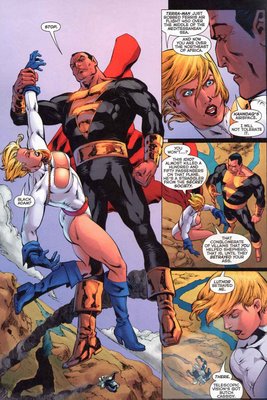
I know he's got the power of Shazam. At this point, who's not aware that he's got no compunction about tearing people limb from limb? But (even though he's surprised her in mid-flight), I don't think Power Girl should allow even Black Adam to get in her face like he does in these two panels:
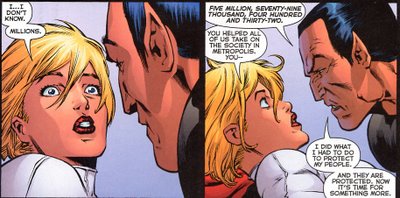
Sure, I'm interested in learning exactly how many people died during the crisis. And I also welcome any opportunity to understand Black Adam's motivations. But I don't think the writer needed to make Power Girl look like a powerless child in order to achieve either of these ends.
Though I had other expectations for the new DCU, it appears that Power Girl is destined to remain a permanent "girl" figure. Though I haven't ever thought this before, maybe the multiverse was a better place. In Power Girl's case, her existence on Earth-Two meant that a writer could depict her as powerful as she needed to be, without any concern that her strength levels might need to be modulated or lessened out of concern for any of the other active Kryptonians.
Though I'm aware that we shouldn't put too much stock in what appears on the covers of our comics, 52 Week 3 has a "crawl text" on the bottom of the cover reading "Power Girl unleashed!" Consequently, though I had found the previous two issues of the title somewhat lackluster, I had high hopes for this one.
I was disappointed.
Things start off well enough, with Power Girl ably in pursuit of a villain, but it went wrong for me when it became clear, in the middle of her appearance, that Power Girl was included in the story not on her own terms, but rather as a device to bolster Black Adam's general bad-assery.

I know he's got the power of Shazam. At this point, who's not aware that he's got no compunction about tearing people limb from limb? But (even though he's surprised her in mid-flight), I don't think Power Girl should allow even Black Adam to get in her face like he does in these two panels:

Sure, I'm interested in learning exactly how many people died during the crisis. And I also welcome any opportunity to understand Black Adam's motivations. But I don't think the writer needed to make Power Girl look like a powerless child in order to achieve either of these ends.
Though I had other expectations for the new DCU, it appears that Power Girl is destined to remain a permanent "girl" figure. Though I haven't ever thought this before, maybe the multiverse was a better place. In Power Girl's case, her existence on Earth-Two meant that a writer could depict her as powerful as she needed to be, without any concern that her strength levels might need to be modulated or lessened out of concern for any of the other active Kryptonians.
Che Says: Two, Three ... Many Catwomen!
How close and bright would the future appear if two, three, many ... flowered on the face of the globe. —From Che Guevara's Message to the Tricontinental, (1966/7).
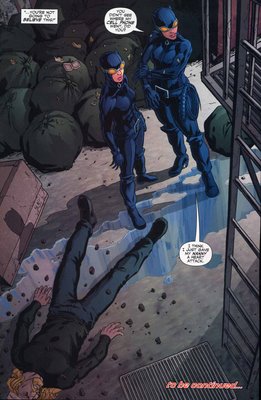
Holly Robinson and Selina Kyle, on the final splash page to Catwoman #55.
(More thoughts on this story arc will follow in a future post.)
Thursday, May 25, 2006
Naming Names
Although X-Statix Presents: Dead Girl ended with a whimper rather than a bang, issue #5 did start off with a fine example of that old standard: a hero facing grave danger reveals her "true" name to her comrades.

(Perhaps Milligan is satirically commenting on Civil War here, too.)
Whatever the reason, Dead Girl's informing us that her name is Moonbeam ranks up there with the Robert Duvall character in Open Range (whom everyone calls "Boss") revealing to Kevin Costner's Charlie that his parents had named him Bluebonnet.

(Perhaps Milligan is satirically commenting on Civil War here, too.)
Whatever the reason, Dead Girl's informing us that her name is Moonbeam ranks up there with the Robert Duvall character in Open Range (whom everyone calls "Boss") revealing to Kevin Costner's Charlie that his parents had named him Bluebonnet.
Monday, May 22, 2006
Young America '76
I re-read Superman #300 (June 1976) this weekend, and all I got was this lousy T-Shirt (ad).

Actually, this is quite an ad: isn't that mop-topped fellow just the definition of 70s youth coolitude?
He's white. He's tall. Centrally placed. Racially tolerant. His head subtly tilts toward the girl, like he's about to pay attention to her. He's a knowing smiler.
And the beaming girl's eyes are focused on his face like a laser.
The ad is a veritable visual description of relaxed alpha malehood.
(And isn't that Todd Bridges on the right, who would go on to memorably portray Willis in TV's Different Strokes?)
However, since it's the 70s, the girl does get to stand on her own in a second (microscopic) picture:


Actually, this is quite an ad: isn't that mop-topped fellow just the definition of 70s youth coolitude?
He's white. He's tall. Centrally placed. Racially tolerant. His head subtly tilts toward the girl, like he's about to pay attention to her. He's a knowing smiler.
And the beaming girl's eyes are focused on his face like a laser.
The ad is a veritable visual description of relaxed alpha malehood.
(And isn't that Todd Bridges on the right, who would go on to memorably portray Willis in TV's Different Strokes?)
However, since it's the 70s, the girl does get to stand on her own in a second (microscopic) picture:

Saturday, May 20, 2006
The Future's Historians

I post this morning not to decry Superman's dickishness, though the cover to Superman #293 (Nov. 1975) depicts a fine example of this that has, of course, been duly noted. (Isn't that Lois Lane pulling on his cape, for goodness' sake?)
No, this morning I'm posting because re-reading this particular issue of Superman's adventures actually provided me with food for thought about the historical profession, and how people in general tend to perceive and identify with the past.
For, joining the reader in a pulse-pounding exploration of Thirsty Thursday is young Joann Jaime, a historian from the 35th century!

Joann helpfully informs the reader that "we futuristic historians, though, don't just record history -- we relive it ..." Now this is the first paragraph of written text on the comic's first page, and already there's something worth reading twice.
Isn't the study of history supposed to deliver humanity from the futility of having to relive (and repeat the errors) of the past? Has the writer, Elliot S! Maggin, slipped in a sly, philosophical statement about the limitations of historical research in there? Sure, we've had loads of time to study the errors of the past, and where did it get us? Did the study of the First World War prevent the Second?
So, with their ability to go back in time, futuristic historians like Joann seem to have it all figured out. Except for ...

(Love that info-screen — Ms. Jaime is on the case!)
It's interesting (and comforting, in a way) to learn that even with their ability to go back and relive the past, the future's historians can't explain how every last thing happened. We're told that historians have been going back to this moment in time every five years in order map out the miracle which occurred on Thirsty Thursday. But no one has ever been able to crack it. And, I'm sorry to report, the estimable and well-prepared Joann fails in the attempt, as well.
The reason why Joann Jaime fails is both simple and profound. The future-travellers who flock to this miraculous and mysterious moment in time find themselves participants in the event, rather than objective observers and gatherers of information. Though they're duty bound not to interact unduly with the people they meet, they are nonetheless subject to the conditions affecting the individuals already living in the time-stream into which they've transported. This insight is one that the futuristic historians haven't fully conceptualized — hence the periodic (and futile) attempts to solve the mystery.
The plot centers upon a run-away chemical reaction which forces the populace to develop a suicidal abhorrence to water. Superman learns that the "antidote" to the exposure is to force the everyone to sleep for 24 hours. He effects this by using his heat vision to release large coulds of sleeping gas into the city. Of course, the gas incapacitates the time-travelling historians in the same way that it does the rest of the population, rendering them unable to discern exactly how Superman (or anyone else) saved the day.
This reads like a clever metaphor for historical research to me. Not so much the insight about a time-traveller becoming a participant, rather than an objective observer. What strikes closer to home is the knowledge that the limitations of evidence and human experience make it impossible for any historical researcher to ever provide a complete representation of the past she's examining. We're forced to recognize the difference between reliving the past and exploring it through research, scholarship, and writing. Rather than simulating time-travel into the historical periods that interest us, our goals must lie elsewhere.
The subtle distinction between living history, and examining and understanding it, is at the heart of Maggin's story. Thinking about the interplay between "reality," subjectivity, evidence, and the simulacra which scholarship allows us to produce brought to my mind Jorge Luis Borges' "On Exactitude in Science," (which is in his Collected Fictions, trans. by A. Hurley, (Penguin, 1998), p. 325. (The story follows in its entirety.)
...In that Empire, the Art of Cartography attained such Perfection that the Map of a single single Province occupied the entirety of a City, and the Map of the Empire, the entirety of a Province. In time, those Unconscionable Maps no longer satisfied, and the Cartographers Guilds struck a Map of the Empire whose size was that of the Empire, and which coincided point for point with it. The following Generations, who were not so fond of the Study of Cartography as their Forebears had been, saw that vast Map was Useless, and not without some Pitilessness was it, that they delivered it up to the Inclemencies of Sun and of Winters. In the Deserts of the West, still today, there are Tattered Ruins of that Map, inhabited by Animals and Beggars; in all the Land there is no other Relic left of the Disciplines of Geography. — Suárez Miranda, Viajes de Varones Prudentes, Libro IV, Cap. XLV, Lérida, 1658
Thursday, May 18, 2006
Sometimes, It's the Simple Things
This afternoon I caught up on my reading of Marvel's New Mangaverse mini-series, written by CB Cebulski, and pencilled by Tommy Ohisuka. (So far, 5 issues have appeared.)
The whacky plot involves stolen superhero accoutrements, several magic rings, sword-fighting mayhem, S.H.I.E.L.D. vs The Hand, inexplicable changes of allegiance, lightning-fast interludes of mind control, and all manner of unlikely heroics. Oh, and the characters are mangaversions of Spiderman, MJ, the Human Torch, the Black Cat, Wolverine, Elektra, and Iron Man.
Since I fall outside of the book's apparent target demographic, I intended to approach it with some measure of ironic (or scholarly) detachment.
However, I'm not ashamed to admit that I'm enjoying every page of the stuff.
Since it made my comic-reading day, I thought I'd share issue #4's final splash page, depicting the mangaverse's Warbird/Carol Danvers rallying the troops for the first time as Captain America:
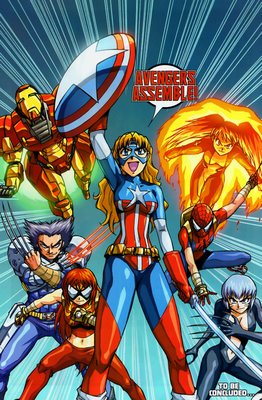
The whacky plot involves stolen superhero accoutrements, several magic rings, sword-fighting mayhem, S.H.I.E.L.D. vs The Hand, inexplicable changes of allegiance, lightning-fast interludes of mind control, and all manner of unlikely heroics. Oh, and the characters are mangaversions of Spiderman, MJ, the Human Torch, the Black Cat, Wolverine, Elektra, and Iron Man.
Since I fall outside of the book's apparent target demographic, I intended to approach it with some measure of ironic (or scholarly) detachment.
However, I'm not ashamed to admit that I'm enjoying every page of the stuff.
Since it made my comic-reading day, I thought I'd share issue #4's final splash page, depicting the mangaverse's Warbird/Carol Danvers rallying the troops for the first time as Captain America:

Wednesday, May 17, 2006
The Sisters, They Are Powerful

Alison Dare and the Heart of the Maiden (written by J. Torres, drawn by J. Bone; Oni Press, 2002) builds nicely on the conventions of the academic-adventurer genre, with a special nod to the Indiana Jones films. Given that the plot is set at a Catholic girl's boarding school, Hayley Mills' The Trouble With Angels (1967) is another crucial reference point.
In issue #1 there's a throwdown between a band of platitude-spouting ninjas and some disguised, sword-wielding nuns. Although its usually foolhardy to predict a positive outcome whenever ninjas are thick on the ground, anyone who's spent even a short time matriculated in a Catholic grade school could tell you how this battle would come out in the end.

After the ninjas vanish, Alison and her friends are understandably filled with questions.

Stupid ninjas. In my old neighborhood, there were two things we were taught not to mess with: there was the union, and there was the nuns.
Tuesday, May 16, 2006
Bibliophilia Ahoy!
There are a million reasons to read comics. Me, I read them for the book love.
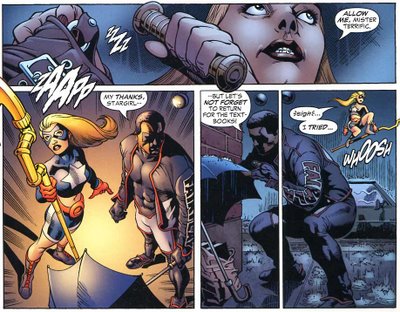
That's Mister Terrific, taking time out of his hectic, phantasm-fighting day to assure that Stargirl's books are protected from the elements. (JSA #83)
For me, those four panels justified the cost of the book.

That's Mister Terrific, taking time out of his hectic, phantasm-fighting day to assure that Stargirl's books are protected from the elements. (JSA #83)
For me, those four panels justified the cost of the book.
Sunday, May 14, 2006
M-Day
A Mother to her Waking Infant
Joanna Baillie (1762-1851)
Now in thy dazzling half-oped eye,
Thy curled nose, and lip awry,
Thy up-hoist arms, and noddling head,
And little chin with chrystal spread,
Poor helpless thing! what do I see,
That I should sing of thee?
From thy poor tongue no accents come,
Which can but rub thy toothless gum:
Small understanding boast thy face,
Thy shapeless limbs nor step, nor grace:
A few short words thy feats may tell,
And yet I love thee well.
When sudden wakes the bitter shriek,
And redder swells thy little cheek;
When rattled keys thy woe beguile,
And thro' the wet eye gleams the smile,
Still for thy weakly self is spent
Thy little silly plaint.
But when thy friends are in distress,
Thou'lt laugh and chuckle ne'er the less;
Nor e'en with sympathy be smitten,
Though all are sad but thee and kitten;
Yet little varlet that thou art,
Thou twitchest at the heart.
Thy rosy cheek so soft and warm;
Thy pinky hand, and dimpled arm;
Thy silken locks that scantly peep,
With gold-tip'd ends, where circle deep
Around thy neck in harmless grace
So soft and sleekly hold their place,
Might harder hearts with kindness fill,
And gain our right good will.
Each passing clown bestows his blessing,
Thy mouth is worn with old wives' kissing:
E'en lighter looks the gloomy eye
Of surly sense, when thou art by;
And yet I think whoe'er they be,
They love thee not like me.
Perhaps when time shall add a few
Short years to thee, thou'lt love me too.
Then wilt thou through life's weary way
Become my sure and cheering stay:
Wilt care, for me, and be my hold,
When I am weak and old.
Thou'lt listen to my lengthened tale,
And pity me when I am frail--
But see, the sweepy spinning fly
Upon the window takes thine eye.
Go to thy little senseless play--
Thou doest not heed my lay.
(1790)
From Eighteenth-Century Women Poets: An Anthology, (ed.), Roger Lonsdale, (Oxford UP, 1989), pp. 442-3.
Joanna Baillie (1762-1851)
Now in thy dazzling half-oped eye,
Thy curled nose, and lip awry,
Thy up-hoist arms, and noddling head,
And little chin with chrystal spread,
Poor helpless thing! what do I see,
That I should sing of thee?
From thy poor tongue no accents come,
Which can but rub thy toothless gum:
Small understanding boast thy face,
Thy shapeless limbs nor step, nor grace:
A few short words thy feats may tell,
And yet I love thee well.
When sudden wakes the bitter shriek,
And redder swells thy little cheek;
When rattled keys thy woe beguile,
And thro' the wet eye gleams the smile,
Still for thy weakly self is spent
Thy little silly plaint.
But when thy friends are in distress,
Thou'lt laugh and chuckle ne'er the less;
Nor e'en with sympathy be smitten,
Though all are sad but thee and kitten;
Yet little varlet that thou art,
Thou twitchest at the heart.
Thy rosy cheek so soft and warm;
Thy pinky hand, and dimpled arm;
Thy silken locks that scantly peep,
With gold-tip'd ends, where circle deep
Around thy neck in harmless grace
So soft and sleekly hold their place,
Might harder hearts with kindness fill,
And gain our right good will.
Each passing clown bestows his blessing,
Thy mouth is worn with old wives' kissing:
E'en lighter looks the gloomy eye
Of surly sense, when thou art by;
And yet I think whoe'er they be,
They love thee not like me.
Perhaps when time shall add a few
Short years to thee, thou'lt love me too.
Then wilt thou through life's weary way
Become my sure and cheering stay:
Wilt care, for me, and be my hold,
When I am weak and old.
Thou'lt listen to my lengthened tale,
And pity me when I am frail--
But see, the sweepy spinning fly
Upon the window takes thine eye.
Go to thy little senseless play--
Thou doest not heed my lay.
(1790)
From Eighteenth-Century Women Poets: An Anthology, (ed.), Roger Lonsdale, (Oxford UP, 1989), pp. 442-3.
Thursday, May 11, 2006
Imaginary Cartography, III

The Annenberg School of Communication at the University of Pennsylvania is hosting a remarkable exhibition of art works from South Africa called Body Maps. The beautiful art on display was produced by thirteen HIV positive women who named themselves The Bambanani Women's Group. (Bambanani meaning "to support each other, to lend hands.")
The director, Jonathan Morgan, describes the project in his introduction to Long Life ... Positive HIV Stories, (Double Storey Books [SA], 2003):
Memory box work, as it is understood in the context of HIV and AIDS, is about preparing for death, and about preparing legacies for children who are soon to become orphans. ... When we began the University of Cape Town's Memory Box Project in Khayelitsha, we noticed that the people we worked with were facing the future more than the past. Life more than death. Out of a larger group who had begun to sketch their stories and dreams of a longer life in their own memory books and boxes, we invited those who wanted to, to tell their stories more publicly.These are large, fascinating, and multi-layered works. Several of them make use of text and photography in addition to painted imagery. And each map incorporates the artist's actual hand- and foot-prints, as well as providing a full-body outline. If you're within range of the Annenberg School, I definitely recommend that you make the trip to see them.
The body map paintings ... rapidly evolved into participatory qualitative research tools, which helped participants to sketch out, paint in and put into words their memories and their stories, which were then captured in the form of narratives ...
The painting on the cover to Long Life is a map by Nomawethu (it's reproduced above); by following the link to the Annenberg School's Body Maps webpage, you can view the maps produced by Babalwa, Bongiwe, Bulelwa, and Cordelia.)
Here's an image of the one made by Victoria:

Each of the creators has provided descriptive material about themselves in the book; here's an excerpt from Victoria's:
When Nomonde and I began this book project, we were meant to be here as facilitators ... But we liked what ... the others [were doing] with the big paintings of their bodies much too much. We joined in, and I was the next person to finish my painting.
[She describes the mark on the left side of her head (a wound caused by a fallen stone); and the mark on her right leg (a dog bite).]
When I was 13 in my culture we cut the fingers, especially the ladies. The boys go to the bush. My father he want to mark his children, his ladies, so they doesn't get lost, especially in Cape Town. If the train hits they must know that mark in the mortuary when they come to find you.
One day they took the sharp knife from the shop and that had never been used to anything and they just cut the finger ... I don't notice it is missing. You are the only one to notice.
...
When I look at this picture I can see what I am, and what I'm not, and what I believe in, and what I don't. I can see that my finger is missing and that I have HIV, but also that I'm strong, very strong.
Wednesday, May 10, 2006
Isn't She From Krypton, Too?
(Spoilers to Infinite Crisis follow in abundance.)

I've been thinking about the narrative structure of Infinite Crisis, and have gotten hung up on Power Girl's role in the sprawling saga.
The first four issues of JSA: Classified placed her at the heart of the gathering storm. In Infinite Crisis #2 she recovered her memories, confirmed that she was a survivor of Krypton-Two, and learned that she had lived as the adopted daughter of the Golden Age Superman and Lois Lane.
She's then courted by Kal-L and Superboy Prime, who want her help in their scheme to restore Earth-Two. Sensibly, Power Girl decided not to lend her support to that genocidal idea, and pretty soon after she voiced her "no" decision, got sucker-punched by Superboy Prime and spent several issues in a comatose state while attached to Alex Luthor's tuning fork machine. (She's released by Wonder Girl, Superboy, and Nightwing in issue #6.)
What's ironic is that in providing Power Girl with a viable origin and restoring her memories of her life with her loving adoptive parents, the writer also severely limited the ways the character could develop and be treated in the later stages of the story. By being cast as "the lost daughter" in the series' underlying family drama, Power Girl became someone of special interest to Kal-L, with the older hero treating her as any (long-lost) father would his child. If he did anything other than intercede to shield her from harm, readers would find his actions to be horribly out of character. Subsequently, (and understandably), Kal-L intercedes in almost every fight in which Power Girl is involved.
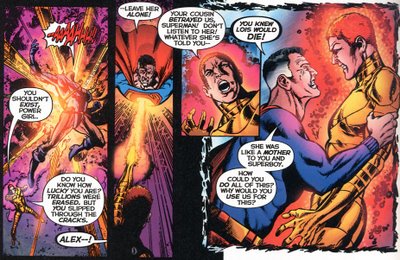
And at the climax of the storyline, Kal-L and Superman arrive at a strategy for dealing with Superboy Prime without consulting her. When Power Girl realizes that the other Kryptonians haven't included her in their plan to take down the crazed villain, it takes the Martian Manhunter to keep her from joining the two Supermen when they speed off.

When I read issue #7, I totally bought Kal-L's line. But at the same time, I couldn't help but think that the version of Power Girl that I first encountered in 1977 would never have allowed those two men to fly off and deal with a grave threat to the universe without her. J'onn J'onzz might have been able to hold that Power Girl back, but, given the circumstances, I've got to believe that he would have had a real fight on his hands.
Geoff Johns is, of course, entitled to embed Power Girl within an Earth-Two family story if he wishes. It's also his prerogative to craft the conclusion of Infinite Crisis so that it might serve as a pivotal defining moment for the two Supermen.
However, I must admit that I can't help wondering what the end of the story might have looked like if Kal-L had seen Power Girl as more of a comrade-in-arms, rather than as someone he needed to protect from harm. Who knows, had she been one of a trio that propelled the villain through Krypton's red sun, perhaps she might have prevented Superboy Prime from beating Kal-L to death on the surface of planet Mogo.

I've been thinking about the narrative structure of Infinite Crisis, and have gotten hung up on Power Girl's role in the sprawling saga.
The first four issues of JSA: Classified placed her at the heart of the gathering storm. In Infinite Crisis #2 she recovered her memories, confirmed that she was a survivor of Krypton-Two, and learned that she had lived as the adopted daughter of the Golden Age Superman and Lois Lane.
She's then courted by Kal-L and Superboy Prime, who want her help in their scheme to restore Earth-Two. Sensibly, Power Girl decided not to lend her support to that genocidal idea, and pretty soon after she voiced her "no" decision, got sucker-punched by Superboy Prime and spent several issues in a comatose state while attached to Alex Luthor's tuning fork machine. (She's released by Wonder Girl, Superboy, and Nightwing in issue #6.)
What's ironic is that in providing Power Girl with a viable origin and restoring her memories of her life with her loving adoptive parents, the writer also severely limited the ways the character could develop and be treated in the later stages of the story. By being cast as "the lost daughter" in the series' underlying family drama, Power Girl became someone of special interest to Kal-L, with the older hero treating her as any (long-lost) father would his child. If he did anything other than intercede to shield her from harm, readers would find his actions to be horribly out of character. Subsequently, (and understandably), Kal-L intercedes in almost every fight in which Power Girl is involved.

And at the climax of the storyline, Kal-L and Superman arrive at a strategy for dealing with Superboy Prime without consulting her. When Power Girl realizes that the other Kryptonians haven't included her in their plan to take down the crazed villain, it takes the Martian Manhunter to keep her from joining the two Supermen when they speed off.

When I read issue #7, I totally bought Kal-L's line. But at the same time, I couldn't help but think that the version of Power Girl that I first encountered in 1977 would never have allowed those two men to fly off and deal with a grave threat to the universe without her. J'onn J'onzz might have been able to hold that Power Girl back, but, given the circumstances, I've got to believe that he would have had a real fight on his hands.
Geoff Johns is, of course, entitled to embed Power Girl within an Earth-Two family story if he wishes. It's also his prerogative to craft the conclusion of Infinite Crisis so that it might serve as a pivotal defining moment for the two Supermen.
However, I must admit that I can't help wondering what the end of the story might have looked like if Kal-L had seen Power Girl as more of a comrade-in-arms, rather than as someone he needed to protect from harm. Who knows, had she been one of a trio that propelled the villain through Krypton's red sun, perhaps she might have prevented Superboy Prime from beating Kal-L to death on the surface of planet Mogo.
Monday, May 08, 2006
Imaginary Cartography, II
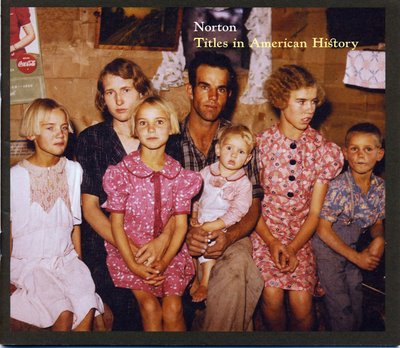
Jack Whinery and his family, homesteaders, Pie Town, New Mexico. September 1940; Library of Congress, FSA-OWI Collection.
The striking and moving image serves as the cover to a book catalogue compiled by W.W. Norton; it has stayed with me since I first saw it a few weeks ago. Though I'm familiar with Walker Evans' riveting photographs of southern sharecroppers and resettled farmers from this period, I'd never before seen an image from this milieu produced in color.
In a metaphorical sense, a photograph of this type can capture and chart familial and social connections, providing a kind of map of this terrain for the viewer. (Will we ever know the first name of Mrs. Jack Whinery, for example?)
Images like this can also evoke emotion by revealing the human dignity retained by non-elite individuals ensnared within economic or social systems geared to strip that very dignity from them.
Saturday, May 06, 2006
Imaginary Cartography
For as long as I can remember, I've always loved maps. The back cover to Rex Libris #4 (Slave Labor Graphics, May 2006) provides an interesting example of a "map of nowhere."
Like all maps, it rewards detailed study in order to master its terrain.
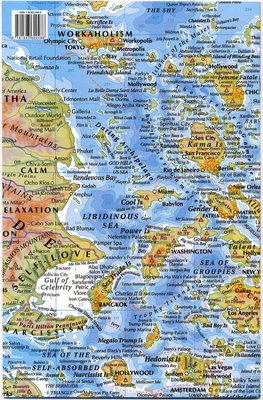
The map is presented without a title. (I looked, but couldn't find supporting information about the image.)
Is this a map of personalities? Relationships? Human needs and desires? Frailties?
Like all maps, it rewards detailed study in order to master its terrain.

The map is presented without a title. (I looked, but couldn't find supporting information about the image.)
Is this a map of personalities? Relationships? Human needs and desires? Frailties?
Friday, May 05, 2006
I'd Buy These
From Rex Libris #4

I was even reaching for my wallet, only to have my hopes dashed by the fine print.
This one's OK, but seems a lot less interesting, now.

I was even reaching for my wallet, only to have my hopes dashed by the fine print.
This one's OK, but seems a lot less interesting, now.
Thursday, May 04, 2006
Unicorns ... Now Ghosts?

A page from JSA #85; Stargirl and Power Girl confront the Gentleman Ghost. Important action: Power Girl is able to land blows upon Craddock, while Stargirl flies right through him. When Power Girl asks, Do you want to explain that? Craddock replies:
Indeed I do not, Power Girl--for I am far too much of a gentleman to comment on such matters.When I read this page on the train yesterday afternoon, I actually said Wait...what? out loud.
So the list of entities that can be relied upon to detect, and react to, female virginity now includes highwaymen ghosts and unicorns? I don't know about you, but I buy my comic books for reasons other than the nausea that I experienced when I read this.
Maybe I'm over-reacting, here, and rather than possessing a virginity-meter, ghosts simply interact differently with women who have given birth to a child, since Power Girl did experience motherhood following her wonderfully empowering mystical pregnancy.
Oh, and I was planning to include an additional Power Girl item from Supergirl #6 here, but Ragnell's already got the goods over at The Written World.
Tuesday, May 02, 2006
The Preferable Pirate
There are some things we know simply because we know them: Luthors are untrustworthy, for example. Others we know because we are taught them: don't point at strangers.
I've found that it's always especially satisfying when something I've previously intuited is backed up for me by objective, real-world evidence. So if you need ammunition for those all-too-frequent which gender pirates best arguments, feel free to reference these panels from Jeff Nicholson's Colonia: Islands and Anomalies, (AiT/Planet Lar, 2002). They explain it all.
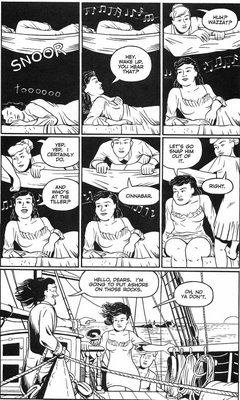
The fact is elegant, logical, and clear: mermaid mojo has absolutely no power over women.
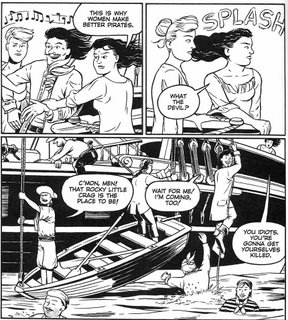
Q.E.D.
I've found that it's always especially satisfying when something I've previously intuited is backed up for me by objective, real-world evidence. So if you need ammunition for those all-too-frequent which gender pirates best arguments, feel free to reference these panels from Jeff Nicholson's Colonia: Islands and Anomalies, (AiT/Planet Lar, 2002). They explain it all.

The fact is elegant, logical, and clear: mermaid mojo has absolutely no power over women.

Q.E.D.
Monday, May 01, 2006
Gabrielle Bell
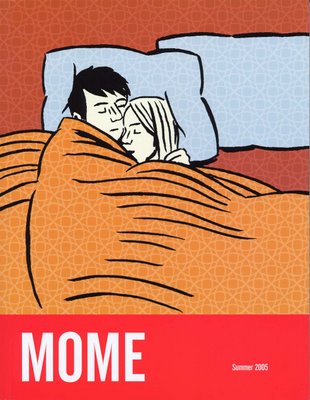
Gabrielle Bell is a prolific New York-based comic artist. She published When I'm Old and Other Stories with Alternative Comic Press in 2003, and her award-winning minicomic Lucky will be compiled and published by Drawn and Quartlerly in October of 2006. (Her artist page at the D&Q website offers an eleven page PDF preview of Lucky.) In addition, Bell will be featured in the upcoming Drawn and Quarterly Showcase volume 4.
I first became aware of Bell's work when I read "Cecil and Jordan in New York" in Kramer's Ergot #5. This story, fantastic and realistic at the same time, centers upon a young woman who, we learn in the midst of the story, is able to transform herself into a chair at will. Cecil is unhappy as Jordan's girlfriend, and fashions a more fulfilling and rewarding existence for herself as a chair/woman chimera occupying another man's living space. (Bell nicely conveys Cecil's sense of serenity and repose in that penultimate panel.)
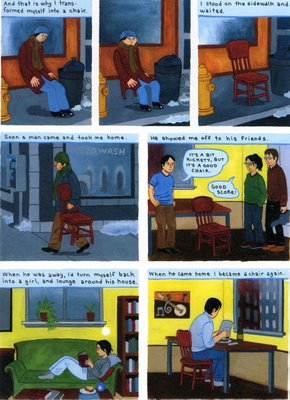
The story closes with some witty and concise narration:
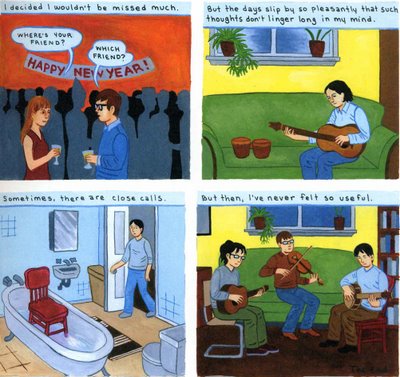
Bell's thoughtful work has recently been appearing in the Fantagraphics anthology Mome. "I Feel Nothing," published in #1, provided the book's cover image. This story contains a particularly well-wrought single page in which Bell shows us how the central character foresees the possible future that might flow from her answering "yes" to a crucial question that's been posed to her.
"Mike's Cafe," in Mome #3, is a playful story-within-a-story: we learn the details of one strand of the narrative as it's fitfully described during a much-interrupted telephone conversation.
Mome #2 has an interview with the artist (conducted by Gary Groth).
Here are some choice quotes:
GG: You never had any ambition to just draw your average, entertaining, mass-market comic book, it sounds like ...
Bell: But I do.
GG: You do?
Bell: Ultimately, I ...
GG: Do you want to draw Catwoman or something?
Bell: What I want is to draw a story that people are interested in and they want to know what's going to happen next. Which I think is the sort of same thing. So I guess I don't want to draw mainstream comics, if that's what you mean. But I think mainstream comics and alternative comics ... Their goal is to tell a story. If it's about fighting crime or if it's about inner demons it's kind of ... That's just the subject matter in a way.
GG: True, but they can have that in commom, but it's how the story is being told that differentiates the two, between literary work and mass-market crap, between a Philip Roth and a Tom Clancy, say. And you seem to have the ambition for the one rather than the other, is that true?
Bell: True, but I think I would ... I mean, it's true but ... The most important thing is to tell a compelling and engaging story. And if it's really obscure and like some kind of art film or very difficult art film, I mean ... I'm just sort of in the middle in a way. Ultimately I think the point of doing comics and of telling stories is to -- I don't want to say entertain -- but it is kind of entertainment. It's to tell a story, which Tom Clancy is doing as well as [Marcel] Proust. They're all telling a story, it's just how much meaning or ... But ultimately I'm into the plot and character change and character development, that kind of thing.
GG: You're more traditional; as distinct from experimental?
Bell: It's all experimental for me because I didn't study formally. So everything I do is an experiment. But the main goal is not just to be experimental but to learn how to tell a good story. I mean, I want to write things that people will like and enjoy reading.
I admire Bell's stand, here. Even though the interviewer has given her the perfect opportunity to take a stand for literature, and provided a platform from which she can denounce mass-market crap, Bell absolutely refuses to rise to the bait. What's more, she even goes so far as to equate Marcel Proust and Tom Clancy, and explain very effectively why and how she's doing it.
Man, I would love to see Gabrielle Bell working on Catwoman.
